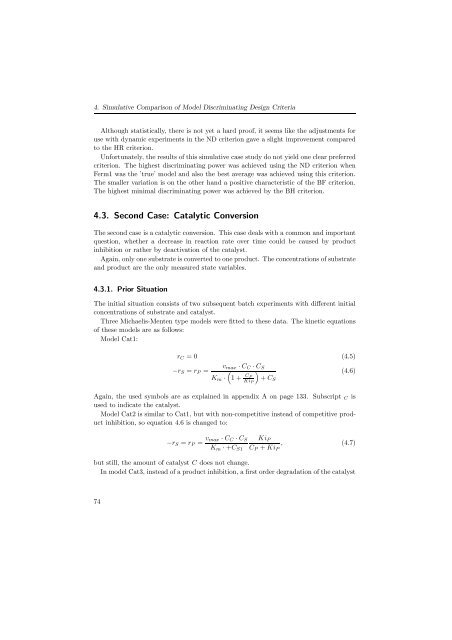Corynebacterium glutamicum - JUWEL - Forschungszentrum Jülich
Corynebacterium glutamicum - JUWEL - Forschungszentrum Jülich
Corynebacterium glutamicum - JUWEL - Forschungszentrum Jülich
You also want an ePaper? Increase the reach of your titles
YUMPU automatically turns print PDFs into web optimized ePapers that Google loves.
4. Simulative Comparison of Model Discriminating Design Criteria<br />
Although statistically, there is not yet a hard proof, it seems like the adjustments for<br />
use with dynamic experiments in the ND criterion gave a slight improvement compared<br />
to the HR criterion.<br />
Unfortunately, the results of this simulative case study do not yield one clear preferred<br />
criterion. The highest discriminating power was achieved using the ND criterion when<br />
Ferm1 was the ’true’ model and also the best average was achieved using this criterion.<br />
The smaller variation is on the other hand a positive characteristic of the BF criterion.<br />
The highest minimal discriminating power was achieved by the BH criterion.<br />
4.3. Second Case: Catalytic Conversion<br />
The second case is a catalytic conversion. This case deals with a common and important<br />
question, whether a decrease in reaction rate over time could be caused by product<br />
inhibition or rather by deactivation of the catalyst.<br />
Again, only one substrate is converted to one product. The concentrations of substrate<br />
and product are the only measured state variables.<br />
4.3.1. Prior Situation<br />
The initial situation consists of two subsequent batch experiments with different initial<br />
concentrations of substrate and catalyst.<br />
Three Michaelis-Menten type models were fitted to these data. The kinetic equations<br />
of these models are as follows:<br />
Model Cat1:<br />
rC =0 (4.5)<br />
−rS = rP =<br />
Km ·<br />
vmax · CC · CS<br />
�<br />
1+ CP<br />
KiP<br />
�<br />
+ CS<br />
(4.6)<br />
Again, the used symbols are as explained in appendix A on page 133. Subscript C is<br />
used to indicate the catalyst.<br />
Model Cat2 is similar to Cat1, but with non-competitive instead of competitive product<br />
inhibition, so equation 4.6 is changed to:<br />
−rS = rP = vmax · CC · CS<br />
Km · +CS1<br />
KiP<br />
, (4.7)<br />
CP + KiP<br />
but still, the amount of catalyst C does not change.<br />
In model Cat3, instead of a product inhibition, a first order degradation of the catalyst<br />
74

















